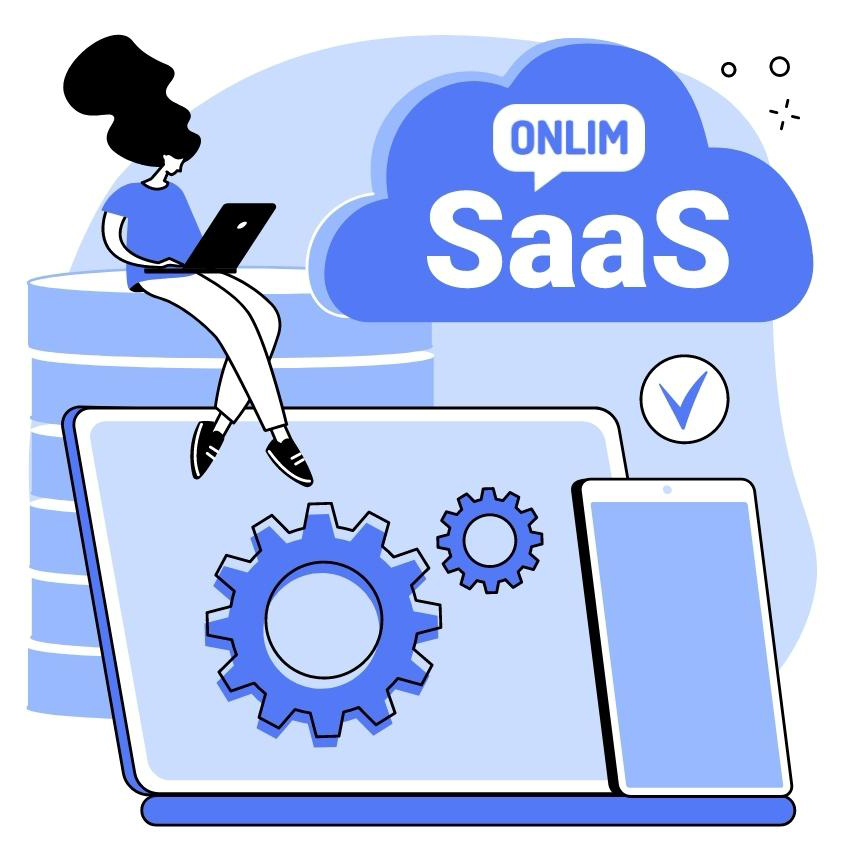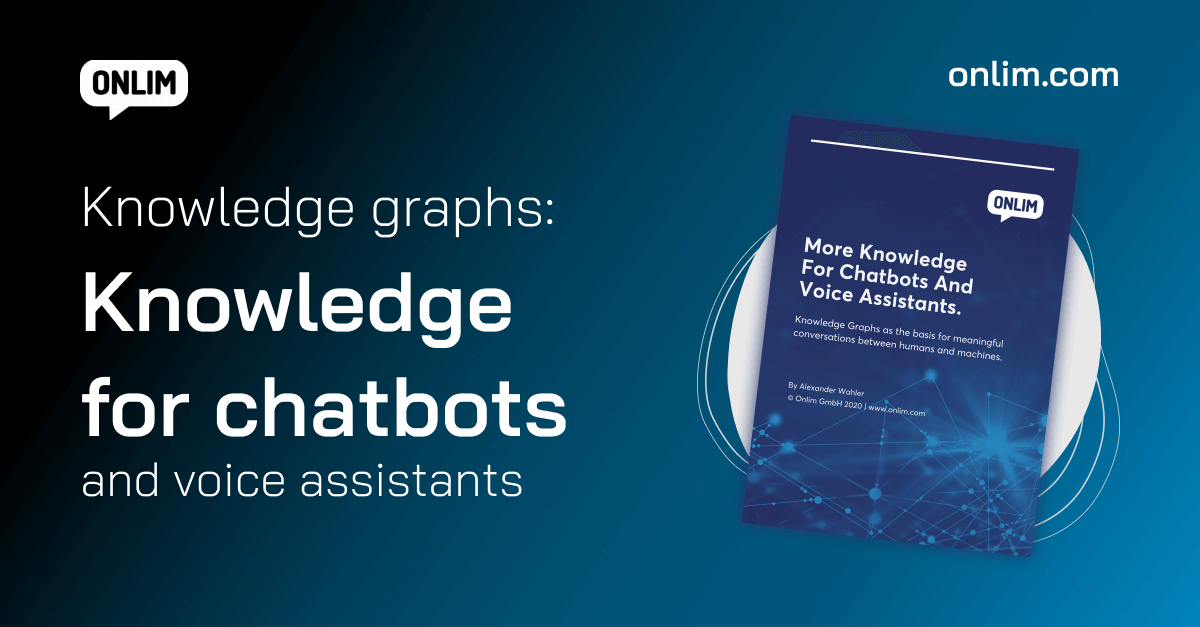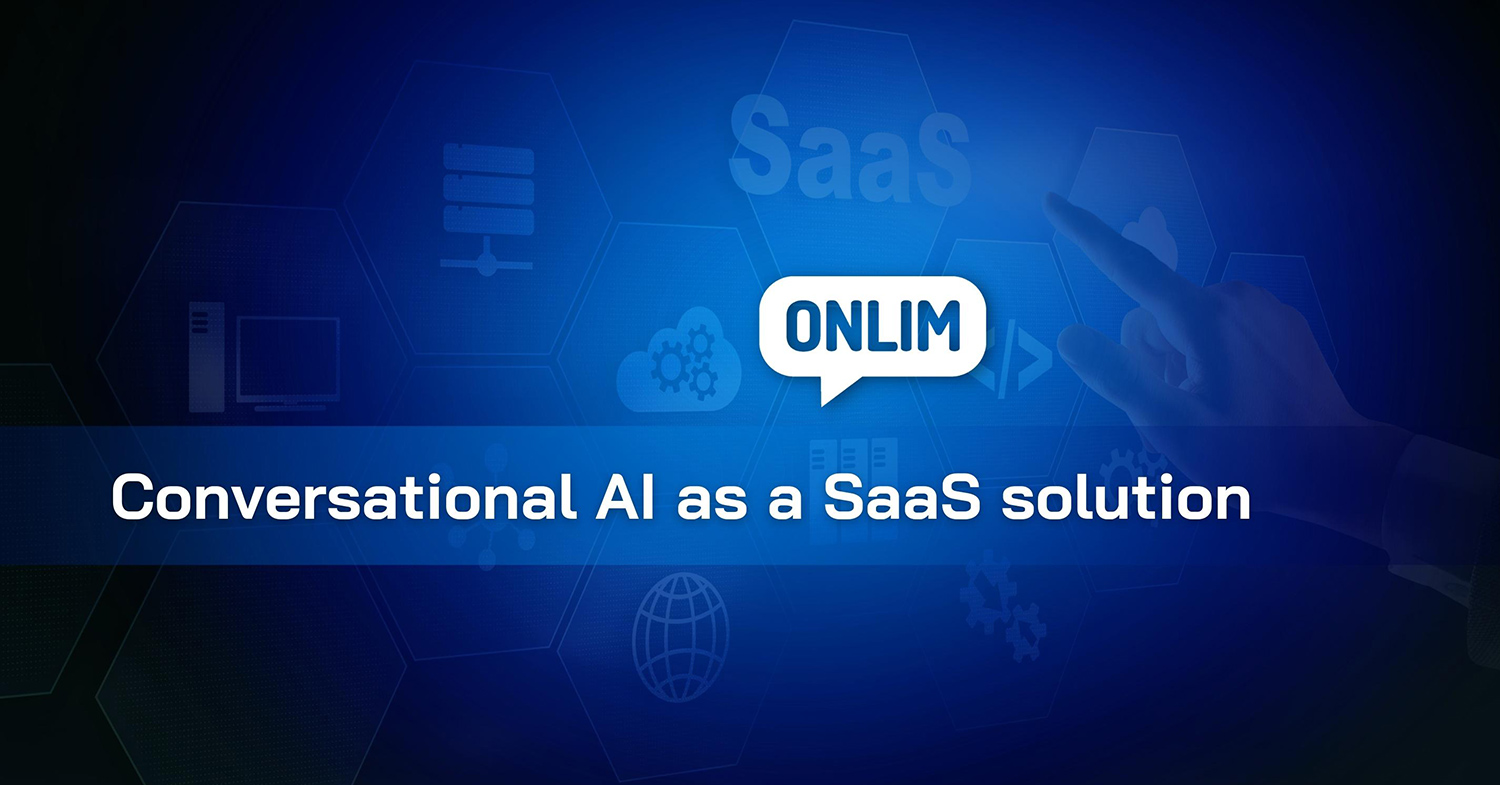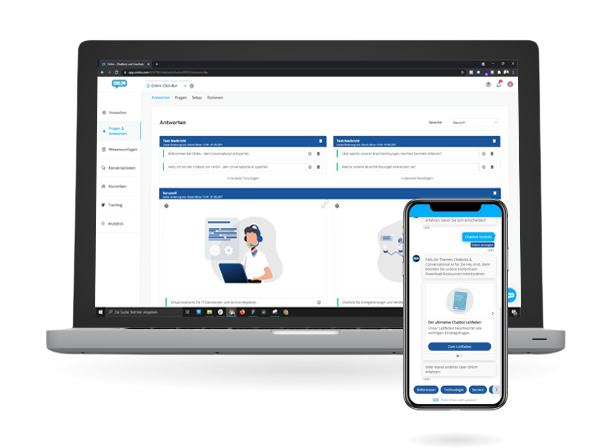Conversational AI as a SaaS solution – What does it mean and what are the benefits?
In the last decade, the implementation of business software in the Software-as-a-Service (SaaS) model has become increasingly popular. At Onlim, we too have developed our Conversational AI solution as SaaS.
In this article we explain why this is the better solution for our customers, which advantages result from it and how Conversational AI via SaaS works exactly.
What is a SaaS solution?

We understand Software-as-a-Service (SaaS) to mean that a provider makes software available to a customer as a holistic service over the Internet, i.e., including IT infrastructure, network, updates, backups, and all other components such as additional data centers.
The increasing popularity of SaaS solutions is due not only to their ease of use, scalability and rapid commissioning, but also to the focus on the company’s own core competencies dictated by global competition.
Why is Onlim’s Conversational AI a SaaS solution?

All companies are faced with the “make, buy or adapt” decision when formulating their innovation strategy. As a matter of principle, it only makes sense for companies to take matters that are crucial to their core business into their own hands; everything else is sourced from experts or technology suppliers and – if necessary – adapted.
At Onlim, we have continuously observed that most companies face the same hurdles and obstacles to bring Conversational AI into the enterprise. It’s not just about analyzing speech and recognizing customer intent but also managing data and service integration. There are also sometimes services from other companies to integrate, which adds to the complexity.
So it became clear very quickly that most customers, after some reflection, come to the decision that they don’t want to develop but buy or adapt. For Buy and Adapt, SaaS is certainly the best solution. Onlim is a SaaS-born solution because while working with large corporate customers, we realized the tremendous expertise and specialization required to bring Conversational AI solutions to enterprises.
Imagine that partners or customers would need to have these updates implemented on-site, which would be required with an on-premise solution.
SaaS solutions: Ease of use hides operational complexity

Users of a SaaS application can conveniently access the SaaS solution directly via browser or mobile device; they do not have to participate in the development and maintenance of the solution on the technical side. This fact gives rise to a glaring asymmetry of information, which carries a certain irony:
Because the use of the service is so easy and convenient for users, the technical complexity and required expertise and specialization for their development is usually greatly underestimated. This is further amplified by the fact that the operator’s efforts and required competencies are difficult to explain and present.
Once customers grasp the complexity and scale of the investment and ongoing costs required to develop such a solution, the willingness and appreciation of implementing it through a trusted partner increases.
Is development and operation of a conversational AI solution complex?
To provide a bit more transparency and clarity on Onlim’s work behind the scenes, in this section we will first look at the loading effort over the last 6 months. We will then follow two types of requests in our system step-by-step.

This graphic shows several aspects: First, it illustrates how closely we monitor our service. We have hundreds of parameters on each server/machine to measure its performance and operation. The graphic further describes that we processed a total of around 367 million requests in the last 56 months.
A closer look reveals that we submit millions of requests a month ourselves to monitor our systems. Every minute, we take samples from different locations around the world to measure availability and performance (speed; latency) of the machines. So we measure from inside the system as well as outside the system from different locations in the world.
No company would carry out this level of operational effort to this extent. In terms of “overengineering”, it would simply not be worth the effort required.
Join 2 requests on their journey through the Onlim system
The starting point is the chat widget (chat management system with caches) that Onlim customers have implemented on their website. When the user opens the web page, a load occurs in the Onlim system to allow the user to be addressed personally in the chat. In fact, these loads represent the vast majority of all loads in the system.
Provided the user interacts with the chatbot, this request is processed through several “AI systems”. First, this starts in the Natural Language Understanding (NLU) module, where the content of the request is analyzed and the customer’s intent is determined (which in turn represents loads).
The query then enters the Natural Language Processing (NLP) layer. Based on the intent and semantics, Onlim searches the customer’s database or knowledge graph for the appropriate information to answer the query. Customer services/interfaces can also be integrated, through which real-time information from the customer can be incorporated into the answer.
The request is forwarded with the retrieved information to the third instance, the Natural Language Generation (NLG). Here we suggest the answer to the end user in natural language in the chatbot or answer their query.
More Knowledge For Chatbots And Voice Assistants

What are the benefits of a SaaS-based Conversational AI solution?
All the well-known advantages and benefits of SaaS solutions can be equally applied to Onlim’s Conversational AI solution:
- Scalability: In the event of workload peaks, the software can be scaled flexibly by adding further servers without affecting the operating speed.
- Availability: Cloud-hosted software is replicated via data centers and offered in a fail-safe manner.
- Instant use: No local installation required, the software can be set up, configured and used immediately.
- Personnel savings: No own personnel required for the development, maintenance and operation of the software, no extensive training necessary.
- Specialization: Clients benefit from Onlim team’s combined 150+ person-years of development experience in the Conversational AI space.
- Flexible use: Extent of use can be adjusted according to actual required conditions. No “overpurchasing” or “underpurchasing”.
- Focus: Customers can focus on core competencies in line with their innovation strategy and obtain supporting services from the expert.
- Simple accounting: Subscription costs can be easily deducted for tax purposes as a monthly operating expense.
- Ongoing updates: Onlim, as a vendor, implemented over 100 minor updates in 2021 without impacting the availability of the service to customers.
- All-round carefree package: As a full-service provider, customers can obtain all the necessary services for implementing a Conversational AI solution from a single source at Onlim.
What does the implementation of a Conversational AI SaaS solution at Onlim look like in concrete terms?
Onlim is a SaaS-based Conversational AI solution that companies can purchase on a subscription model and adapt according to their actual usage. Onlim acts as a full-service provider and takes over the ongoing maintenance and further development in the backend as well as the provision of Conversational AI as a Service.
Companies can fully concentrate on using the service and take advantage of the associated process optimizations, insight gains and efficiency improvements. Onlim hosts in a German data center and thus ensures availability, performance and scalability of the service at all times.
The value of SaaS is that users can focus entirely on using the service and are relieved of any technical or administrative overhead. Thus, customers can not only realize the full benefits of the application in a timely manner, but also benefit from all the other advantages listed above.
Isolated requests for on-premise implementation ebb away
In general, more and more IT service providers and departments are convinced of the superiority of SaaS services; no wonder given the wealth of benefits (as outlined previously).
In some cases, however, procurement departments initially advocate an on-premise solution due to a lack of prior knowledge, especially in the case of state-regulated companies.
However, we can reassure our interested parties: DSGVO compliance is of course guaranteed. All services are offered from a single source by Onlim, and are provided from our own private cloud in a German data center.
Procurement of SaaS solutions: Service levels must be defined
It is important for customers to have clarity about the requirements of the solution to be purchased. For this purpose, the required service levels (SL) must be defined for the service level agreement (SLA) to be concluded with the technology provider.
What is an SLA? Which SL and SLAs are required? How can SLAs be negotiated and agreed? Once this clarity is reached, it can be ensured that exactly the right scope of functionality is purchased. Overpurchasing and underpurchasing are avoided.
Client to-dos during the implementation of a Conversational AI SaaS solution.
The SaaS solution frees the customer from many tasks and expenses, but some level of cooperation is still required during the initial implementation of Onlim, depending on the use case.
The details differ from case to case, which may or may not be very data or service-heavy. With SaaS, the customer can focus on implementation and deployment. The most important task of the customer is to make the choice between a voice and text based bot, and to support us with the intent detection, which is set, improved and continuously monitored in the background.
The customer should continuously monitor the incoming requests or intents and develop the bot accordingly so that all user requests can be answered. The customer must provide the content in a structured form by uploading or typing, so that the customer queries can be answered in the best possible way.
There are two ways in which the customer’s data can reach Onlim: On the one hand, the customer can import it already structured, or it can be accessed by Onlim via APIs and imported into the system.
What can we expect in the future?
The use of SaaS solutions in the enterprise sector is definitely a megatrend that has already been emerging for the last 5-10 years. Even for insiders, this ever-increasing pace of transformation is so fast that it’s hard to keep up.
Companies are under increasing pressure to keep up with technological change and implement it as cost-effectively as possible. The direction of focusing on core competencies in the innovation strategy will continue to intensify – and with it the use of SaaS services such as Onlim’s Conversational AI solution.
This is also being driven by increasing regulation and more complex legislation in dealing with data, which requires expert knowledge.
For further questions or feedback on the topic, please feel free to contact us here.
Retrieval Augmented Generation (RAG)
July 10th, 2024|
Is a voicebot right for my company?
June 18th, 2024|
What is Generative AI?
June 11th, 2024|




